Research Policy Analysis and Coordination
Scope of Work (Exhibit A)
Jump to:
- Project Summary/Abstract
- Scope of Work
- Schedule of Deliverables (Exhibit A1)
- Key Personnel (Exhibit A2)
- Authorized Representatives and Notices (Exhibit A3)
- Use of Intellectual Property & Project Data (Exhibit A4)
- Résumés/BioSketch (Exhibit A5)
- Current & Pending Support (Exhibit A6)
In its proposal, the University will include a Scope of Work (which may have been prepared by the University, the State, or both parties). At the top of Exhibit A, the University will select whether the agreement will be a grant or contract and whether or not this is a research project.
Note:
- If the state agency disagrees with the University’s determination of whether the agreement is a contract or a grant, the state agency can check the correct box for contract or grant at the award stage.
- If the state agency disagrees with the University’s determination of whether the project includes research, the state agency can check the correct box for whether the project includes research at the award stage.
The University will populate the PI Name and Project Title.
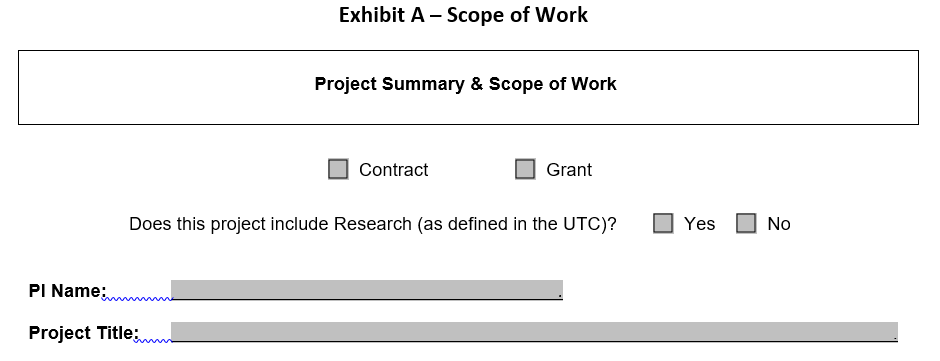
Government Code §13989 et seq, imposes open access publication obligations on University recipients of research grants from Stage agencies. These requirements, including when they are triggered, are set forth in Exhibit C (the University Terms and Conditions (UTC)) at section 17, Right to Publish in the University Terms and Conditions.
The University shall indicate if the project to be funded includes research. For the purposes of this question research is defined as an investigation or experimentation aimed at the discovery and interpretation of facts, revision of accepted theories or laws in the light of new facts, or practical application of such new or revised theories or laws.
Please also note that if the contract or grant is a research project, all applicable regulatory and compliance safeguards must be addressed prior to initiation of the project, including processes relating to human subject and animal protection (which may include the approval of the California Committee for the Protection of Human Subjects; see also 45 C.F.R. § 46 and California Civil Code § 1798.24).
Project Summary/Abstract
The Project Summary/Abstract serves as a succinct and accurate description of the proposed work when separated from the application and may be populated by the University. This section can include the proposal’s long-term objectives and the specific aims of the proposed work. This section should be informative to persons working in similar or related fields and understandable to a scientifically or technically literate reader. Avoid describing past accomplishments and the use of the first person.

Below the Project Summary/Abstract are two checkboxes related to circumstances where third-party confidential information could be provided to University by the State. The parties are to consult with each other to determine if either circumstance applies to the agreement and ensure that this portion is completed either at the proposal stage or at the time of award.

Scope of Work (Exhibit A)
Below the Summary/Abstract and checkboxes is space for the full Scope of Work (Exhibit A).

The University will describe the goals of the proposed project and summarize the expected outcomes. It will include the specific objectives of the project, e.g., to test a stated hypothesis, solve a specific problem, challenge an existing paradigm or clinical practice, address a critical barrier to progress in the field, or develop new technology or methodology. The State should carefully review the Scope of Work to ensure it meets the agency’s needs and to work out any ambiguities or questions with the University.
The University will describe the overall strategy, methodology, and analyses to be used to accomplish the specific aims of the project, including a description of work to be performed by any subawardees, subrecipients and subcontractors. It will include how the data will be collected, analyzed, interpreted, and if required, delivered, as well as any resource sharing plans as appropriate. The potential problems, alternative strategies, and benchmarks for success anticipated to achieve the aims should be included.
Agency RFP forms note: If the proposal process of the state agency requires a particular form or forms, then the agency grant proposal forms should be used. At the award phase, the Scope of Work page(s) of the state application package can be labeled “Exhibit A” and added to the CMA award package, so long as no terms and conditions are included in the Scope of Work.
Schedule of Deliverables (Exhibit A1)
Exhibit A1 includes a bifurcated table for listing all items that will be delivered to the State under the proposed Scope of Work, which may include reports, including draft reports for State review, and if requested by the State and agreed to by the Parties, data sets, and software.
Agency RFP forms note: Any deliverables included in the Agency-specific proposal forms must, at the award stage, be populated on Exhibit A1.
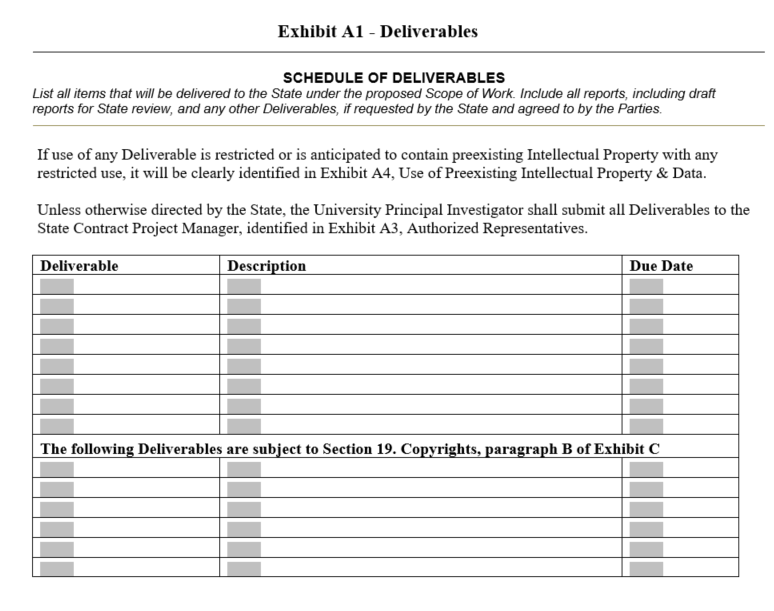
For any Deliverables listed in the top half of the table at Exhibit A1, the University will own the copyright to the Deliverables and the State will have a license to use such Deliverables per UTC Section 19 (A).
For any Deliverables listed in the bottom half of the table at Exhibit A1, the State agency will own the copyright to Deliverables, subject to a reserved right for the University to use the copyrightable work for educational and research purposes and to allow other educational and nonprofit institutions to do so for educational and research purposes, unless such use is prohibited by law.
It is important for the parties to carefully review Exhibit A1 to ensure their intent as to which party will own the copyright for identified Deliverables is accurately reflected in the contract.
If use of any Deliverable is restricted or is anticipated to contain Preexisting Data or copyrightable works with any restricted use, populate part C of Exhibit A4, Use of Intellectual Property & Project Data.
Key Personnel (Exhibit A2)
The University will identify Key Personnel on Exhibit A2. Key Personnel are defined as the PI and other individuals who contribute to the scientific development or execution of a project in a substantive, measurable way, whether or not they receive salaries or compensation under the agreement.
Typically, these individuals have doctoral or other professional degrees, although other individuals should be included if their involvement meets the definition of Key Personnel. Key Personnel does not include students or other named staff not specifically required for completion of the Scope of Work.
In Exhibit A2, the University will list the PI, by last name, first name followed by Co-PIs. Then, all other Key Personnel will be listed by last name. For each individual on this exhibit, the University will include his/her name, institutional affiliation, and role on the proposed project. Additional consecutively numbered pages can be used as necessary. It is important that only Key Personnel are listed on Exhibit A2, as any changes in Key Personnel throughout the project will require prior approval, and likely a formal amendment, from the State agency.
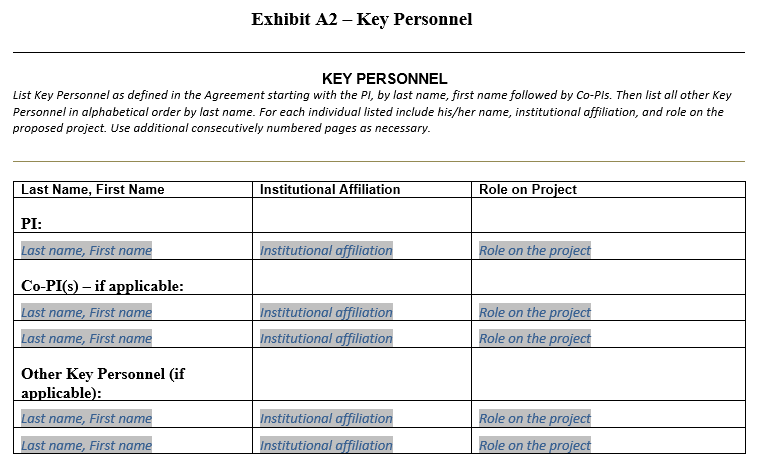
Authorized Representatives and Notices (Exhibit A3)
As part of the proposal package the University will fill in the University Contacts section of Exhibit A3. The funding State agency will fill in the corresponding State contacts in Exhibit A3 when a funding agreement is issued.
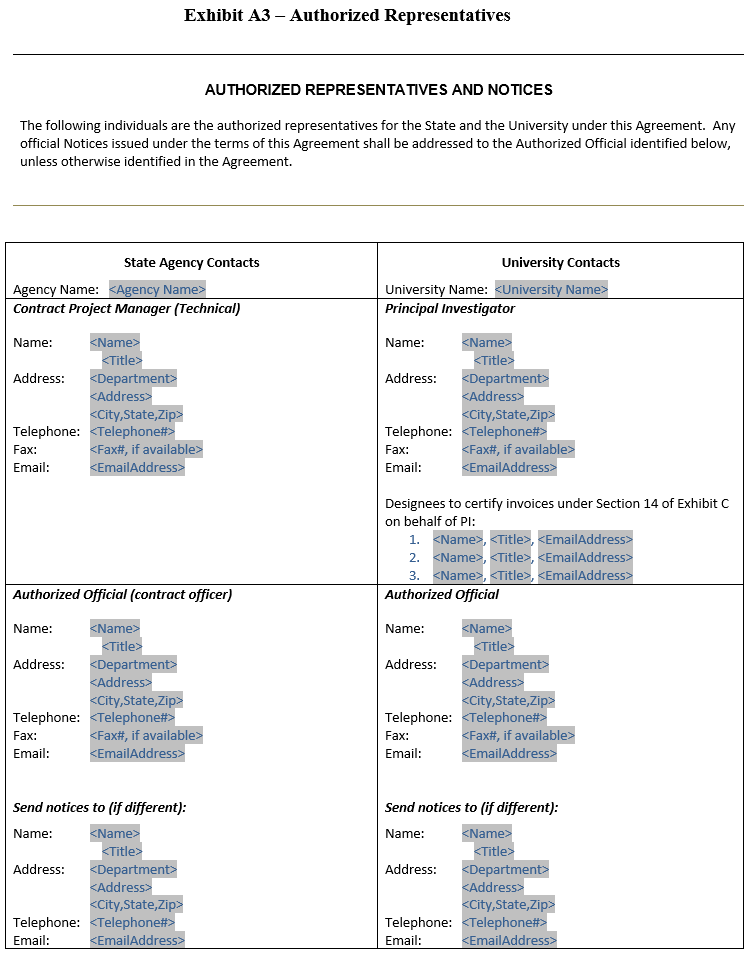
The Authorized Official for the University is the representative in the Sponsored Projects, Contracts & Grants, or Business Contracts Office, who can commit the institution to the agreement, amendments thereto, and receive notices on behalf of UC, CSU or the state agency, respectively. The Administrative Contact is the individual responsible for the day-to-day administration of the agreement. The Fiscal Contact is the representative authorized to certify the accuracy of the invoices submitted to the State under the agreement. As the University supplies this information at the proposal stage, the State shall identify its authorized representatives and contacts prior to the agreement being executed.
As Section 14 of Exhibit C requires PI (or designee) certification of the invoices submitted to the state agency for payment, alternate investigators or signors may be added in this section and will have authority to certify when the PI is not available.
Similarly, to allow some flexibility in financial certification of each invoice, the Authorized Financial Contact for the University may also designate alternate individuals with authority to certify invoices, as indicated below.
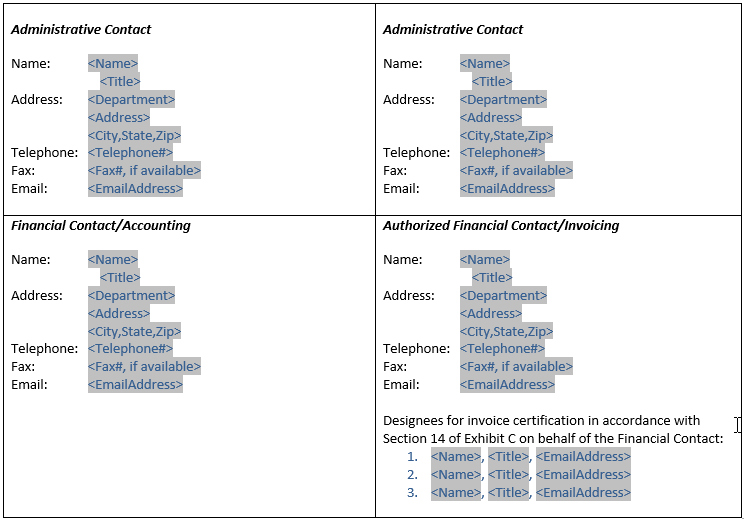
Use of Intellectual Property & Data (Exhibit A4)
This exhibit is used to identify all intellectual property and/or data that may have restrictions on use because they are not owned by either party or have licensing restrictions.
As part of the proposal submission, the University will leave Section A of Exhibit A4 blank. This section is to be filled out by the State if the State is providing intellectual property or data with use restrictions.
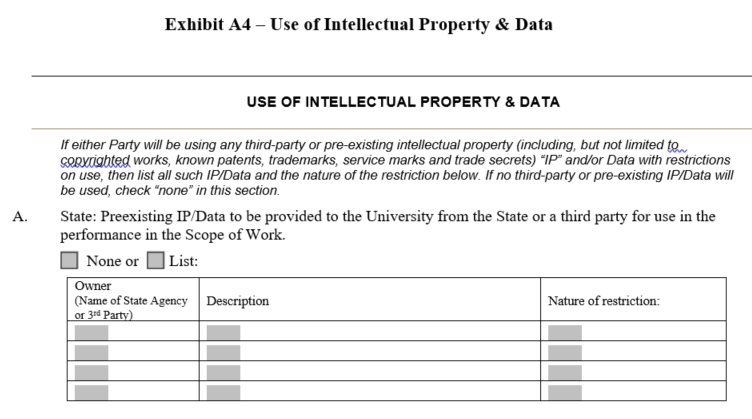
If the University knows of any third-party or pre-existing intellectual property or data that have restrictions on use and will be included in Deliverables listed at Exhibit A1, then the University is to list all such pre-existing intellectual property or data and the nature of the restriction in Section B of Exhibit A4. If no third-party or pre-existing intellectual property or data is anticipated to be included in Deliverables, check “none” in this section.

If the University PI anticipates that any of the Project Data generated during the performance of the Scope of Work will have a restriction on use (such as laws preventing the use or disclosure of personally identifiable subject information contained in a data set) then the University is to list all such anticipated restrictions in Section C of Exhibit A4. If there are no anticipated restrictions on use of the Project Data, then check “none” in this section.

Résumé/BioSketch (Exhibit A5)
Utilize Exhibit A5 to attach a resume or biosketch, whichever appropriate for the agreement. See California Public Contract Code § 10371 and consult with the subject state agency for details.
Current & Pending Support (Exhibit A6)
University will provide current & pending support information for Key Personnel identified in Exhibit A2. The sample below is intended to provide guidance regarding the type and extent of information requested on the Current & Pending Support Form. The “Proposed Project” is this application that is submitted to the State. It is required and represents the scope of the projects of the Key Personnel.
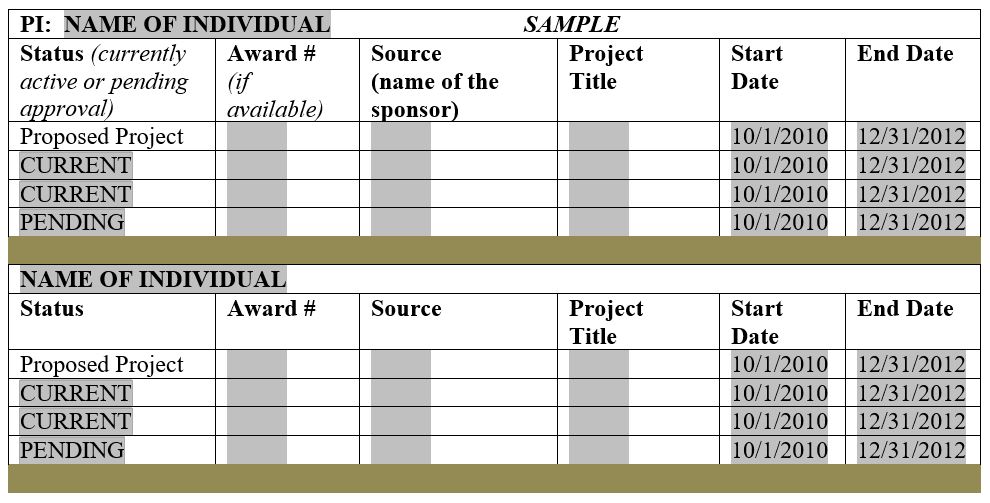
Please use the following to complete the information for current and pending support:
Information on active and pending support is required for Key Personnel. For individuals with no other active or pending support, indicate “None.”
Status: Identify if project is currently funded or pending approval.
Award Number: If available, include a code or identifier for the award.
Source: Identify the agency, institute, foundation, or other organization that is providing the support.
Project Title: Provide the full project title for each entry.
Dates of Approved/Proposed Project: Indicate the inclusive dates of the project as approved/proposed.
